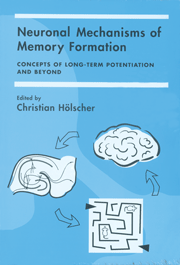Book contents
- Frontmatter
- Contents
- Contributors
- Introduction: Long-Term Potentiation as a Model for Memory Mechanisms: The Story So Far
- Section One Long-Term Potentiation In Vitro and In Vivo: How Can We Fine-Tune the Current Models for Memory Formation?
- Section Two There is More to the Picture Than Long-Term Potentiation: Theta or Gamma Oscillations in the Brain and the Facilitation of Synaptic Plasticity
- Section Three Making Models from Empirical Data of Synaptic Plasticity
- Section Four Setting the Stage for Memory Formation: Stress, Arousal, and Attention
- Section Five Transgenic Mice as Tools to Unravel the Mechanisms of Memory Formation
- Conclusions and Future Targets
- Index
Introduction: Long-Term Potentiation as a Model for Memory Mechanisms: The Story So Far
Published online by Cambridge University Press: 13 October 2009
- Frontmatter
- Contents
- Contributors
- Introduction: Long-Term Potentiation as a Model for Memory Mechanisms: The Story So Far
- Section One Long-Term Potentiation In Vitro and In Vivo: How Can We Fine-Tune the Current Models for Memory Formation?
- Section Two There is More to the Picture Than Long-Term Potentiation: Theta or Gamma Oscillations in the Brain and the Facilitation of Synaptic Plasticity
- Section Three Making Models from Empirical Data of Synaptic Plasticity
- Section Four Setting the Stage for Memory Formation: Stress, Arousal, and Attention
- Section Five Transgenic Mice as Tools to Unravel the Mechanisms of Memory Formation
- Conclusions and Future Targets
- Index
Summary
What Is LTP?
At present, long-term potentiation (LTP) of synaptic transmission is the most widely studied model for neuronal change that occurs during learning and that stores information in the brain. When Bliss and Lømo discovered the phenomenon of LTP 30 years ago, it must have been a very exciting moment (see Bliss and Lømo, 1996, for a detailed account). The finding was an important step in the long ongoing search for the neuronal basis of memory formation in the nervous system. Even though anatomists such as Exner showed changes in neuronal connections that were induced by exposure to rich environments as early as 1884 (Exner, 1884), it was by no means clear how exactly neurons change in order to store information. Exner and others (Hebb, 1949; Hinton, 1992; Jodar and Kaneto, 1995) proposed activity-dependent, selective plastic changes in the connections between neurons that could “freeze” the pattern of activity of the neurons and therefore preserve information. The theoretical basis for LTP existed for a long time, and when LTP was described by Bliss and Lømo in a full paper (Bliss and Lømo, 1973), researchers in the field were more than ready for the actual empirical evidence that neuronal network processes might be used in the brain.
The basic principle of every neuronal net is that connections between neurons can change in a defined, use-dependent way thereby storing information. Such a system has certain attributes such as pattern completion, parallel processing, and self-instructing learning properties, all of which are characteristics of activity in working brains (Hinton, 1992; Jodar and Kaneto, 1995).
- Type
- Chapter
- Information
- Neuronal Mechanisms of Memory FormationConcepts of Long-term Potentiation and Beyond, pp. 1 - 34Publisher: Cambridge University PressPrint publication year: 2000



